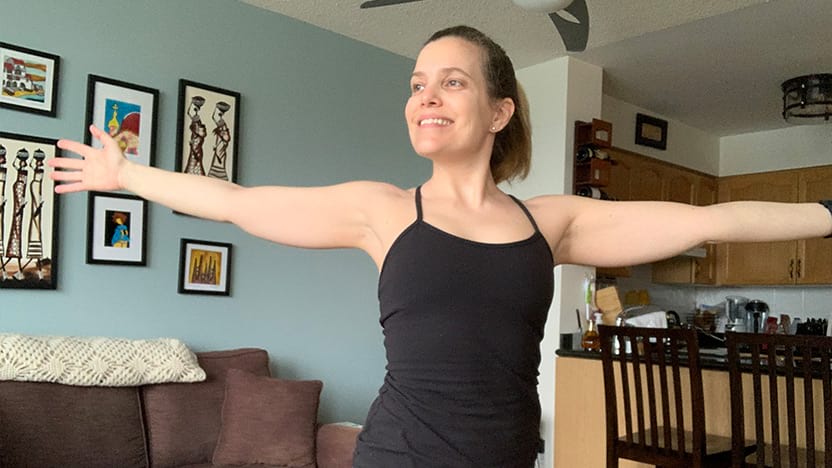DAY 21
Modifications and flexion-free exercise options
Learn how to modify some of the most popular exercises to make your online workouts safer for your body.

Not having an instructor around to correct your positioning and modify your movements can make following an online workout program difficult for some people. Listening to your body’s needs (and consulting your doctor) is key when exercising alone at home. You can also practice low-impact movements, remove weights/props and familiarize yourself with modifications to make the exercises safer and more comfortable in your body.
You can also hire an instructor to teach you virtually or tune into a live class where the instructor can see you to get individualized support.
In this article, Lead Instructor Trainer Sarah Jarvis demonstrates some modifications and flexion-free exercise options that you can try at home.
1. Hip Rolls
With feet on the floor, it may be difficult for some people to roll evenly through the spine, specifically the low back. To allow for more even articulation, place the feet or calves on an ottoman, low chair, stool or Stability Ball™. Having the feet elevated allows more ease of motion through the low back and can provide more range at the hip and better glute/hamstring connection. A flexion-free client can do a Hip Lift (like a Shoulder Bridge) instead of Hip Rolls, maintaining neutral instead of articulating through the spine to work the glutes and hamstrings.
2. Side Leg Lifts
If you feel a strain in your neck during Side Leg Lifts, put a couch cushion or pillow under your head. If you feel discomfort in your bottom hip, place a folded towel underneath to cushion it. Remember if you feel like it’s hard to balance in a side-lying position, bend your bottom leg and just focus on your top hip muscles.
3. Plank
If you find it difficult to do a Plank on your forearms or hands, use a strong and sturdy chair or table, which will angle your body and bring more weight to your feet and less load on your shoulders/hands.
4. Spine Twist
This exercise can be done in a seated, kneeling or standing position. Traditionally it is done seated in a Matwork class, but sometimes it feels better to do the Spine Twist standing for people with restrictions in the hips, knees or spine.
5. Push-ups
This exercise is very difficult to do correctly on the mat. But you can easily modify it to prevent injury in the neck, shoulders and scapulae. Here are a couple options. Place your hands on a strong and sturdy counter, table or chair to modify the angle of your body. This will put less pressure on your upper body and place more weight on your feet, allowing you to maintain proper alignment and optimal movement of the arm in the shoulder joint. The other option is to perform this from a four-point kneeling position with hands under shoulders and knees under hips. As the elbows bend, the hips will hinge, allowing the torso to lower to the mat. This version also puts less weight on the arms while building strength in the abs and arms. This is a good option for someone who is less sensitive in the wrists and is able to get down to the floor.
Remember, health experts suggest you talk to your doctor before starting any new exercise program. If using a table, chair or counter for these modifications, ensure that the structure is stable, balanced and can safely support your body weight.